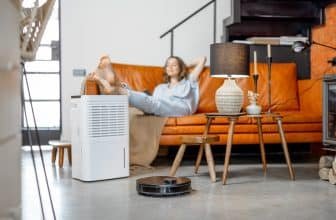Air Purifiers for Car: Top Options for Cleaner Air on the Go
Driving in a car means spending a lot of time in a confined space, breathing in air that might be less than fresh. This can be a concern for anyone, especially those with allergies or asthma. Installing a car air purifier can significantly improve the air quality inside a vehicle by removing pollutants, allergens, and odors. This simple addition can make every drive more comfortable and healthier.

There are many car air purifiers on the market, each with its own set of features. Some are highly portable, fitting snugly into cup holders, while others are more powerful with advanced filtration systems like HEPA filters. Whether looking for the best dedicated unit or a multi-purpose gadget, there are options to suit different needs and budgets.
For those unsure about which air purifier to choose, it’s helpful to look at reviews and ratings from trusted sources. The IQAir Atem and the Philips GoPure GP5212 are highly recommended for their efficiency and ease of use. These devices not only improve air quality but also add to the overall driving experience by ensuring that every breath of air in the car is clean and fresh.
Key Takeaways: Air Purifiers for Car
- Installing a car air purifier can improve air quality and make driving healthier.
- Various car air purifiers come with different features and prices.
- Reviews can help identify the best air purifiers like the IQAir Atem and Philips GoPure GP5212.
Understanding Car Air Purifiers
Car air purifiers help reduce airborne pollutants in vehicles, making the air cleaner and healthier to breathe. They utilize various technologies like ionizers and HEPA filters to remove dust, bacteria, and other harmful particles.
Types of Car Air Purifiers
HEPA Filters: These are highly efficient at trapping particles as small as 0.3 microns, making them effective for removing dust, pollen, and bacteria. HEPA filters are often considered the gold standard in air filtration, capturing 99.97% of airborne particles.
Ionizers: These devices release negative ions that attach to pollutants, causing them to fall or stick to surfaces rather than remain airborne. While effective in reducing particulate matter, they may produce ozone as a byproduct, which can have health implications.
Combination Units: Some air purifiers use a mix of HEPA filters and ionizers. These offer the benefits of both technologies, capturing fine particles and reducing airborne contaminants through ionization.
Activated Carbon: Often used in conjunction with other technologies, activated carbon filters excel at removing odors and gasses from the air, such as volatile organic compounds (VOCs).
How Air Purifiers Work
Air purifiers for cars work by drawing in air and passing it through various filters. HEPA filters capture small particles, while activated carbon filters focus on odors. Ionizers release negative ions that bond with airborne particles, making them easier to capture or removing them from the air stream altogether.
One key feature to look for is the type of technology used, as this will determine the purifying efficiency. For example, HEPA filters are better for allergens, while ionizers may suit general air freshness. It’s important to understand these mechanisms to choose the right purifier for specific needs.
Benefits of Using a Car Air Purifier
Using a car air purifier can significantly improve air quality inside the vehicle. HEPA filters can reduce allergens like pollen and dust, beneficial for people with allergies or asthma. Ionizers can cut down on smoke and fine particles, enhancing overall comfort.
Another benefit is the reduction of unpleasant odors through activated carbon filters, which are effective against VOCs and other pollutants. Additionally, these devices can help eliminate bacteria and mold, providing a healthier environment, especially on long trips or in highly polluted areas.
Choosing the Right Car Air Purifier
When selecting a car air purifier, it’s important to consider factors like size, portability, and filtration efficacy. These elements help ensure that the device fits well in your car, is easy to use, and effectively cleans the air.
Factors to Consider
Key factors include size, portability, filtration efficacy, noise, and price. First, check the dimensions. A car air purifier shouldn’t take up too much space. Look for units that fit in cup holders, on the dashboard, or behind headrests.
Evaluate filtration efficacy by considering the type of filter. A True HEPA filter can capture tiny particles, while ionizers can neutralize odors. Also, consider the device’s noise level. Quieter models are less intrusive. Finally, compare prices to find a model that fits your budget without sacrificing quality.
Size and Portability
Car air purifiers come in various sizes, from compact units to larger models. Portable air purifiers that fit snugly in cup holders or hang on the back of seats are ideal. Ensure the unit won’t obstruct driving or passenger space. The IQAir Atem, for example, is a sleek, plate-sized design that doesn’t take up, cupholder space while offering high efficacy.
Look for devices with secure mounting options to prevent movement during travel. Westinghouse Portable WH10P is known for its versatile mounting choices. For those who need to frequently move the purifier between vehicles, lightweight models with easy-to-use attachments are preferable.
Filtration Efficacy
Choosing a unit with an effective filtration system ensures that harmful particles are removed from the car air. True HEPA filters, found in high-end models like the IQAir Atem, are crucial for trapping particles as small as 0.3 microns.
Consider additional features such as activated carbon filters for removing odors and gaseous pollutants. For multi-functional use, some units like the Pure Enrichment PureZone, combine purification with ionization technology, enhancing their ability to cleanse the air of unwanted particles and smells. Look at specifications related to CADR (Clean Air Delivery Rate) for an objective measure of the purifier’s effectiveness.
Top Car Air Purifiers on the Market
When choosing a car air purifier, it’s important to consider both premium and budget-friendly options as well as customer reviews to find a product that saves money and delivers high performance.
Premium Picks
For those seeking the best in technology and design, the IQAir Atem Car Portable HEPA Air Purifier stands out. It’s compact and attaches to the back of your seat’s headrest. This device filters particles 100 times smaller than 0.3 microns, making it effective against pollutants and odors. Another top choice is the Luftrum C-401, known for its dedicated car air purifying capabilities.
Budget-Friendly Options
For those looking for more affordable choices, the Philips GoPure GP5212 offers high-performance HEPA filtration for a reasonable price. This purifier is particularly praised for removing up to 100 different air pollutants efficiently. Another cost-effective option is the Pure Enrichment PureZone Mini Portable, which offers portability and ease of use in any vehicle.
Customer Reviews
Customer feedback highlights several key factors for choosing the best car air purifier. The IQAir Atem is often noted for its efficiency and ease of use. Positive reviews frequently mention its ability to improve air quality significantly. In the budget category, the Philips GoPure GP5212 and the Pure Enrichment PureZone Mini Portable receive praise for their affordability and effectiveness. Consumers appreciate how these models make clean air accessible without breaking the bank.
Installation and Maintenance
In this part, you’ll learn how to properly set up your car air purifier, keep it in good condition, and know when it’s time to replace the filters.
Setting Up Your Air Purifier
To set up your car air purifier, first locate a good spot for it. Most people place it on the dashboard or clip it onto an air vent. Make sure the device doesn’t obstruct your view or interfere with the car’s controls.
Plug the air purifier into the car’s cigarette lighter or USB port. If it’s a rechargeable model, ensure it is fully charged before use. Follow any additional instructions specific to your model for optimal performance.
Check the noise level of the purifier when it’s running. A very loud device can be distracting while driving. Many modern car air purifiers are designed to operate quietly.
Maintaining Your Air Purifier
Regular maintenance is essential for the longevity of your air purifier. Start by checking the manufacturer’s cleaning recommendations. Most units require periodic dusting and wiping down to remove any accumulated dirt or grime.
Clean the exterior with a damp cloth and avoid using harsh chemicals. If the unit has a washable pre-filter, remove it and clean it according to the instructions. Disposable filters should be replaced as needed.
Monitor the performance of the purifier. If you notice a decrease in air quality or an increase in noise level, it might be time for a thorough cleaning or filter replacement. Keep an eye on any indicator lights which may alert you to necessary maintenance activities.
When to Replace Filters
HEPA filters and other types of filters need regular replacement to function effectively. Check your purifier’s user manual for specific timelines, but a general rule is to replace the filters every six to twelve months.
Many units come with indicator lights that notify you when a filter change is necessary. If your purifier lacks this feature, keep a schedule as a reminder. Some purifiers use replacement filters that are easily available online or at electronics stores.
Always purchase the correct filter model recommended by the manufacturer to ensure compatibility and performance. Properly disposing of the old filters is also important; follow any local guidelines for electronic waste. Regular filter replacement keeps the air purifier working efficiently and maintains air quality in your car.
Health Benefits and Considerations

Using an air purifier in your car can significantly improve your respiratory health by removing pollutants like dust, smoke, and allergens. There are some misconceptions about air purifiers, and it’s important to know the potential risks of ozone emission from certain models.
Air Purifiers and Respiratory Health
Car air purifiers can improve respiratory health by filtering out pollutants such as dust and smoke. HEPA filters, often cited as the gold standard in air filtration, remove up to 99.97% of particles as small as 0.3 microns, which includes most allergens, bacteria, and mold. This can be especially beneficial for individuals with asthma or allergies.
Breathing clean air while driving means fewer allergens like pollen and pet dander. This reduces coughing, sneezing, and other allergy symptoms. For people living in areas with high pollution levels, an air purifier can significantly lower the amount of contaminants inhaled, decreasing the risk of respiratory ailments.
Avoiding Common Misconceptions
There are several misconceptions about car air purifiers. Ionizers are often thought to be as effective as HEPA filters, but they simply charge particles rather than removing them. This can cause particles to cling to surfaces rather than being eliminated from the air. It’s important to choose an air purifier with a true HEPA filter for the best results.
Another common belief is that all air purifiers generate ozone. While older models and some ionizers do produce ozone, many newer models do not. It’s essential to research and select an air purifier designed to minimize or eliminate ozone production to avoid exacerbating respiratory issues.
Risks of Ozone Emission
Certain air purifiers, particularly those with ionizers, can emit ozone, a reactive gas that can worsen asthma and other respiratory conditions. Ozone is harmful because it can cause chest pain, coughing, throat irritation, and shortness of breath, making it a concern for individuals with pre-existing health issues.
To ensure safety, look for air purifiers that are certified for low ozone emissions. Some manufacturers clearly state that their newer ionizer models do not produce ozone. Always check product specifications and certifications to avoid these health risks and choose a model that prioritizes clean, safe air.
Learn more about car air purifiers at the Smart Air guide or explore the various models available at The Healthy.
Frequently Asked Questions
This section covers the benefits of using car air purifiers, the effectiveness of HEPA filters and car ionizers, and tips for maintaining and choosing car air purifiers.
What are the benefits of using an air purifier in a car?
Using an air purifier in a car helps remove pollutants like dust, pollen, and other allergens. It can improve the air quality inside the vehicle, contributing to a healthier driving environment.
How effective are HEPA filters in car air purifiers?
HEPA filters are highly effective at trapping particles as small as 0.3 microns. They can remove a significant portion of harmful contaminants, including allergens and pollutants, enhancing the air quality inside the car.
Can car air purifiers eliminate tobacco smoke effectively?
Car air purifiers, especially those with HEPA filters, can reduce tobacco smoke particles. Many can also neutralize smoke odors, making the air inside the vehicle cleaner and fresher.
What should one look for when choosing a portable air purifier for a car?
When selecting a portable air purifier for a car, consider the size of the unit, its power source, and battery life. It’s also important to check the type of filter it uses and any additional features like USB charging or multi-purpose functionality.
Are car ionizers effective in improving air quality inside vehicles?
Car ionizers can help improve air quality by emitting negative ions that attach to pollutants, causing them to settle out of the air. However, their effectiveness can vary and may be less than that of HEPA filters.
How can one maintain a car air purifier to ensure optimal performance?
Regularly check and clean or replace filters as recommended by the manufacturer. Keep the air purifier free from dust and debris, and ensure it is properly charged or connected to a power source for optimal performance.






